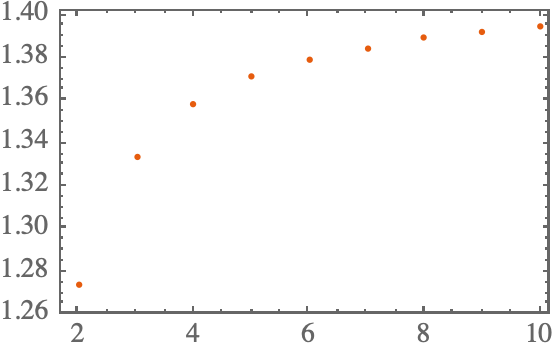What is the best approach to estimate, with Wolfram Mathematica, the expected Euclidean distance in a $(n+1)$-dimensional space between two points selected uniformly at random on the unit $n$-sphere? The approach I have in mind uses an expression whose length is proportional to $n$, while I would like a simpler and more elegant approach.
-
$\begingroup$ To clarify, do you mean distance in Euclidean n+1 space or distance on the sphere itself? $\endgroup$– Daniel LichtblauCommented Nov 21, 2020 at 16:18
-
$\begingroup$ Are the points inside the sphere or on the surface? $\endgroup$– Daniel HuberCommented Nov 21, 2020 at 16:23
-
$\begingroup$ @DanielHuber An $n$-sphere is the surface of an $(n + 1)$-dimensional ball. $\endgroup$– Penelope BenenatiCommented Nov 21, 2020 at 17:07
-
$\begingroup$ @DanielLichtblau I am referring to the Euclidean distance in the $(n+1)$-dimensional space (not the great-circle distance). $\endgroup$– Penelope BenenatiCommented Nov 21, 2020 at 17:09
-
1$\begingroup$ Disregard my comment, I was not thinking it through clearly. $\endgroup$– Daniel LichtblauCommented Nov 22, 2020 at 15:01
3 Answers
Not an exact answer but a Monte-Carlo way of checking the exact answers.
Generate a random point on the unit $n$-sphere:
P[n_Integer?Positive] := Normalize[RandomVariate[NormalDistribution[], n]]
Measure the mean distance between a random point $P_0$ and another random point on the unit $n$-sphere, by averaging over $m$ random points:
M[n_Integer?Positive, m_Integer?Positive] := With[{P0 = P[n]},
Mean[Table[Norm[P[n] - P0], {m}]]]
Try for different values of $n$:
M[1, 10^6]
(* 0.998648 *)
The result is 1.
M[2, 10^6]
(* 1.27374 *)
This matches @flinty's result of $4/\pi$.
M[3, 10^6]
(* 1.33315 *)
This matches @flinty's result of $4/3$.
More values:
Table[M[n, 10^6], {n, 1, 10}]
(* {0.998648, 1.27374, 1.33315, 1.35903, 1.37166,
1.37969, 1.38504, 1.38929, 1.39232, 1.39459} *)
Update
I think the exact answer is
d[n_] = 2^(n-1)*Gamma[n/2]^2/(Sqrt[π]*Gamma[n-1/2])
For large $n$ the mean distance is therefore approximately
Series[d[n], {n, ∞, 1}]
(* Sqrt[2] - 1/(4 Sqrt[2] n) + O(1/n)^2 *)
-
$\begingroup$ Thank you @Roman . Do you know how to extend this solution for a unit $n$-hemisphere (instead of a unit $n$-sphere)? $\endgroup$ Commented Nov 21, 2020 at 16:24
-
1$\begingroup$ I think that's much harder because hyperspherical symmetry is broken. $\endgroup$– RomanCommented Nov 21, 2020 at 16:33
-
1$\begingroup$ Yes I think that it should be a new question, it's too different from this one. $\endgroup$– RomanCommented Nov 21, 2020 at 17:18
-
1$\begingroup$ Well done getting what appears to be the exact form. How did you manage it? $\endgroup$– flintyCommented Nov 21, 2020 at 18:01
-
2$\begingroup$ @flinty The distance between two points on the $n$-hypersphere is $2\sin(\theta/2)$ in terms of their angle (scalar product) $\vec{a}\cdot\vec{b}=\cos\theta$. Averaging over the Jacobian $J_n\propto\sin^{n-2}\theta$:
Table[Integrate[2*Sin[θ/2]*Sin[θ]^(n-2), {θ, 0, π}]/Integrate[Sin[θ]^(n-2), {θ, 0, π}], {n, 2, 10}]and then useFindSequenceFunction[%, n-1]to discover the formula for arbitrary $n$. $\endgroup$– RomanCommented Nov 21, 2020 at 18:15
For $n=3$:
The PDF is $f(d) = d/2$ or in Mathematica TriangularDistribution[{0, 2}, 2] - a ramp shaped distribution. We can test this numerically and we get a high $p$-value of about 0.31 so it's a good fit:
points = RandomPoint[Sphere[], {1000000, 2}];
distances = EuclideanDistance @@@ points;
testdist = TriangularDistribution[{0, 2}, 2];
DistributionFitTest[distances, TriangularDistribution[{0, 2}, 2]]
Show[Histogram[distances, 1000, "PDF"],
Plot[PDF[testdist, x], {x, 0, 2}], Plot[d/2, {d, 0, 2}]]
The expected distance is Mean[testdist] which gives $4/3$. Or you can do this yourself as an integral
$$ \int_{0}^{2} x\cdot\frac{x}{2} dx = \frac{4}{3} $$
For $n=2$:
You can integrate around the circle to find the average holding one point fixed.
Integrate[
EuclideanDistance[{0, 1}, {Cos[θ], Sin[θ]}],
{θ, 0, 2 π}]/(2 π)
(* result: 4/Pi *)
-
$\begingroup$ Thank you @flinty ! My problem is to find an estimation when the number of dimensions $n$ is very large, without writing a list of constraints, i.e., one constraint per dimension when $n\gg1$. How can we solve this problem? Maybe it is worth to create a list of constraints first, and then use it with a wolfram command. $\endgroup$ Commented Nov 21, 2020 at 16:17
-
1$\begingroup$ For other dimensions, the approximate distribution looks a bit like
TransformedDistribution[2 x, x \[Distributed] BetaDistribution[a, b]]over domain $0<x<2$, where for $n=2, \alpha=1, \beta=1/2$, $n=3, \alpha=2, \beta=1$, $n=4, \alpha=3, \beta=3/2$, ... However, these are approximate - I'm not sure if those parameters are exact. $\endgroup$– flintyCommented Nov 21, 2020 at 16:17 -
1$\begingroup$ @PenelopeBenenati for $n>3$ to create a point on the $n$-sphere, just generate $n$ variates from a normal distribution, and
Normalizethe point:points = Partition[ Normalize /@ RandomVariate[NormalDistribution[0, 1], {1000000, n}], 2]; distances = EuclideanDistance @@@ points;$\endgroup$– flintyCommented Nov 21, 2020 at 16:19 -
RandomPoint can be used to sample from arbitrary Region definitions, and Sphere describes the unit sphere in $R^n$ (it can be both a geometric region and a graphics primitive). So @flinty's original solution can be generalized to arbitrary numbers of dimensions. Using this type of approach avoids having to know very much about the problem (as in @Roman's solution).
A Monte Carlo based way to estimate this can look like the following:
(*sample Euclidean distances of pairs of points*)
distanceDistributionOnSphere[dimensionality_, nSamples_ : 10^5] :=
With[
{randomPointsOnSurfaceOfNSphere = RandomPoint[Sphere[dimensionality], {nSamples, 2}]},
EuclideanDistance @@@ randomPointsOnSurfaceOfNSphere]
(*Evaluate mean of the sample*)
MeanAround /@ distanceDistributionOnSphere /@ Range[10]
This yields the same results as noted above.
It may also make it easier to generate a region that combines a Sphere with a HalfPlane in order to implement the subsequent question in the comment thread about hemisphere distances, but I don't know enough about $n>3$ dimensional geometry to implement that correctly....
-
$\begingroup$ Thank you very much @Joshua Schrier . Here you can find the post: mathematica.stackexchange.com/q/235101/74045 $\endgroup$ Commented Nov 21, 2020 at 18:12


